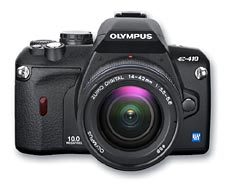The 10-megapixel Olympus E-410 updates the E-400 with a new Live MOS image sensor, and new TruePic III image processor.
Olympus E-410 Review
Performance
Supercharged E-400
Being based closely on the E-400, it’s not that surprising that the E-410 performs in a very similar fashion in many areas. In use, however, it’s fairly obvious that Olympus has tinkered under the bonnet to ‘supercharge’ its latest model. One of the biggest differences is its speed when it comes to taking consecutive frames.
Burst Speed
We criticised the E-400 earlier this year because it was just a little too slow when it came to taking sequences of images. Even when you simply wanted to take a couple of shots in succession of the same scene, there was a slight delay between frames.
With the E-410 this is largely resolved, and if you are shooting the highest-quality JPEGs you’ll see a vast improvement, especially if you accept the second-highest-quality HQ JPEG files. With these files you can rattle off more frames than you need – Olympus claims 100, but if you need more than 20 in a row we’d be surprised, and the E-410 achieves this with ease. This is most likely due to the E-410’s new processor, and possibly also due to its larger buffer.
Yet while JPEG capture has improved, the E-410 still isn’t the camera we’d choose for sport or action photography, where Raw files are wanted. Despite being faster, the buffer is still limited and if you’re shooting Raw you’ll find that after eight frames the camera needs to take a breather. Still, it’s certainly better than its predecessor for when you need to shoot sequences.
AF Performance
There is still a question mark over the focusing system’s ability to keep up with such frame rates, though. With fast-moving subjects, it doesn’t quite pick the subject up and track it as well as some DSLRs (Pentax’s K100D, for example). Pre-focusing ensures your initial frame will be crisp, but depending on the subject’s speed and direction across the frame, you may find that subsequent images get softer as the three-point AF system struggles.
For more sedate subject matter, though, the E-410’s AF system performs very well, locking on quickly in bright conditions and only hesitating slightly when things are a little darker or the contrast in your subject is low.
Live View Focusing
There is also the benefit of the live view LCD system if you are shooting static subjects such as landscape or macro/still life with a tripod. A single press of the display button activates the rear LCD, in effect turning the E-410 into a ‘compact’ where you can compose your image using the large 2.5in screen. However, because of the way live view works you can only focus manually, but this is no great problem. Pressing the ‘ok’ button in live view mode zooms the preview image to 7x magnification, which is perfect for precision focusing. In fact, the system works incredibly well, and for landscape and still-life photographers is far preferable to using the slightly small viewfinder for framing pictures. If we have one slight criticism it’s that you have to remember to switch to manual focus yourself before entering live view mode, and we’re surprised that Olympus hasn’t programmed the camera to automatically switch between focusing modes when live view is activated.





